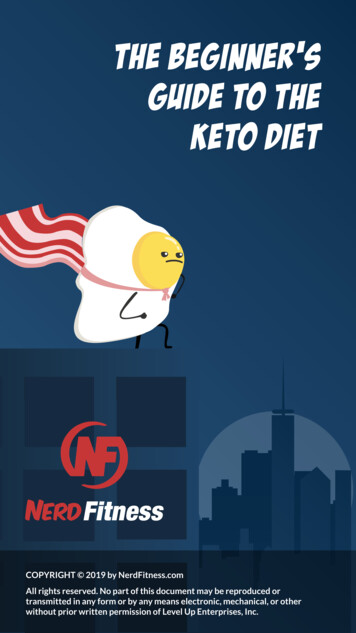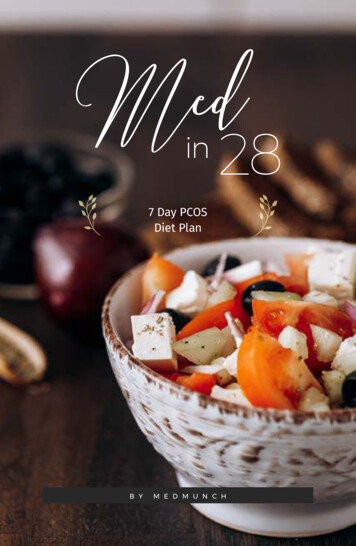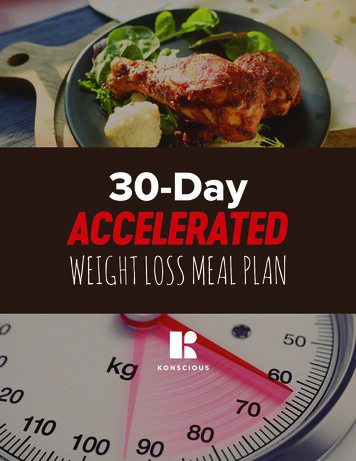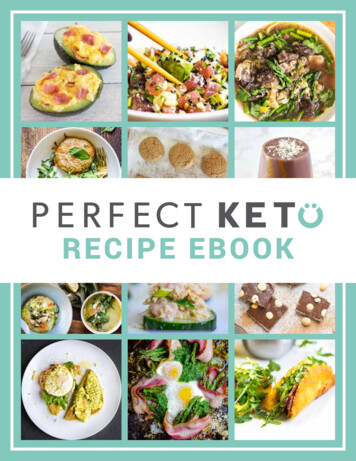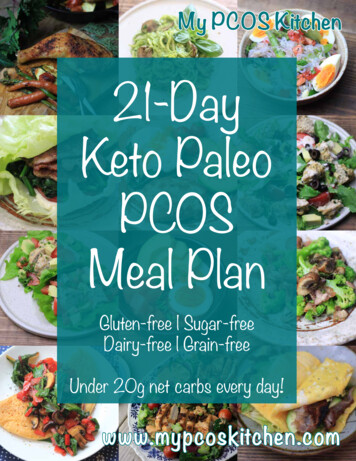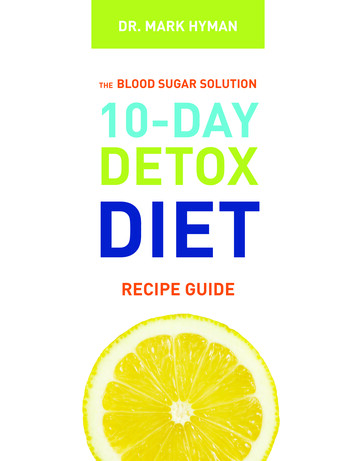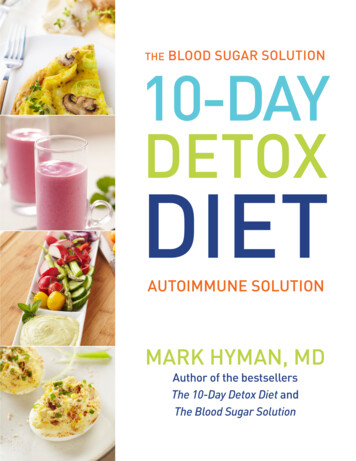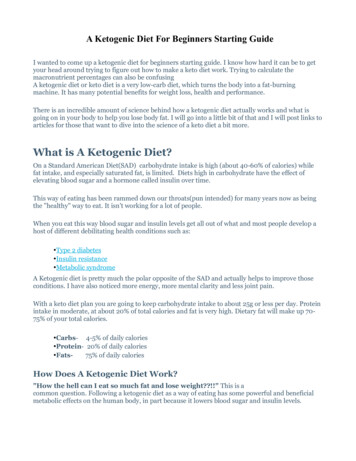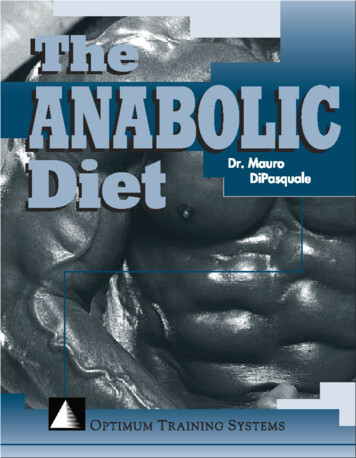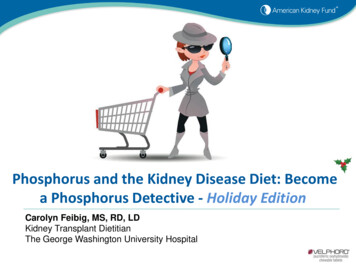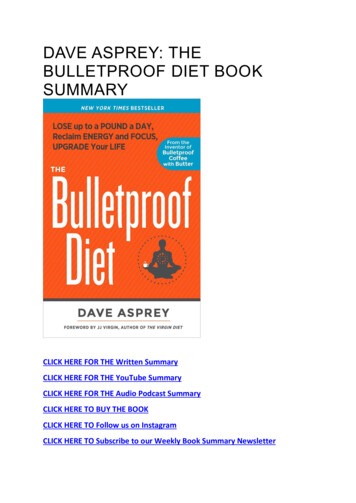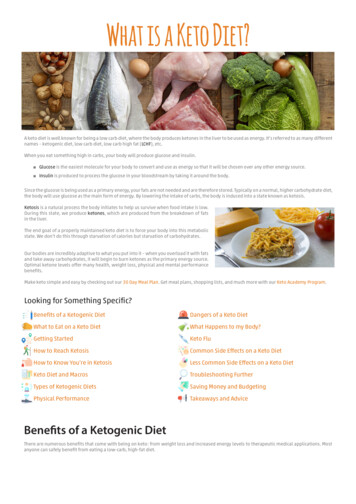
Transcription
What is a Keto Diet?A keto diet is well known for being a low carb diet, where the body produces ketones in the liver to be used as energy. It’s referred to as many differentnames – ketogenic diet, low carb diet, low carb high fat (LCHF), etc.When you eat something high in carbs, your body will produce glucose and insulin. Glucose is the easiest molecule for your body to convert and use as energy so that it will be chosen over any other energy source. Insulin is produced to process the glucose in your bloodstream by taking it around the body.Since the glucose is being used as a primary energy, your fats are not needed and are therefore stored. Typically on a normal, higher carbohydrate diet,the body will use glucose as the main form of energy. By lowering the intake of carbs, the body is induced into a state known as ketosis.Ketosis is a natural process the body initiates to help us survive when food intake is low.During this state, we produce ketones, which are produced from the breakdown of fatsin the liver.The end goal of a properly maintained keto diet is to force your body into this metabolicstate. We don’t do this through starvation of calories but starvation of carbohydrates.Our bodies are incredibly adaptive to what you put into it – when you overload it with fatsand take away carbohydrates, it will begin to burn ketones as the primary energy source.Optimal ketone levels offer many health, weight loss, physical and mental performancebenefits.Make keto simple and easy by checking out our 30 Day Meal Plan. Get meal plans, shopping lists, and much more with our Keto Academy Program.Looking for Something Specific?Benefits of a Ketogenic DietDangers of a Keto DietWhat to Eat on a Keto DietWhat Happens to my Body?Getting StartedKeto FluHow to Reach KetosisCommon Side Effects on a Keto DietHow to Know You’re in KetosisLess Common Side Effects on a Keto DietKeto Diet and MacrosTroubleshooting FurtherTypes of Ketogenic DietsSaving Money and BudgetingPhysical PerformanceTakeaways and AdviceBenefits of a Ketogenic DietThere are numerous benefits that come with being on keto: from weight loss and increased energy levels to therapeutic medical applications. Mostanyone can safely benefit from eating a low-carb, high-fat diet.
Weight LossThe ketogenic diet essentially uses your body fat as an energy source – so there areobvious weight loss benefits. On keto, your insulin (the fat storing hormone) levels dropgreatly which turns your body into a fat burning machine.Scientifically, the ketogenic diet has shown better results compared to low-fat and highcarb diets; even in the long term.Many people incorporate MCT Oil into their diet (it increases ketone production and fatloss) by drinking bulletproof coffee in the morning.Control Blood SugarKeto naturally lowers blood sugar levels due to the type of foods you eat. Studies evenshow that the ketogenic diet is a more effective way to manage and prevent diabetescompared to low-calorie diets.If you’re pre-diabetic or have Type II diabetes, you should seriously consider a ketogenicdiet. We have many readers that have had success with their blood sugar control on keto.You can read their success stories here Mental FocusMany people use the ketogenic diet specifically for the increased mental performance.Ketones are a great source of fuel for the brain. When you lower carb intake, you avoidbig spikes in blood sugar. Together, this can result in improved focus and concentration.Studies show that an increased intake of fatty acids can have impacting benefits to ourbrain’s function.You can read a few more benefits of keto for the brain by clicking here Increased Energy & Normalized HungerBy giving your body a better and more reliable energy source, you will feel more energizedduring the day. Fats are shown to be the most effective molecule to burn as fuel.On top of that, fat is naturally more satisfying and ends up leaving us in a satiated (“full”)state for longer. If you’re interested in the science behind how ketosis works, read morehere EpilepsyThe ketogenic diet has been used since the early 1900’s to treat epilepsy successfully. It isstill one of the most widely used therapies for children who have uncontrolled epilepsytoday. Learn more at The Charlie FoundationOne of the main benefits of the ketogenic diet and epilepsy is that it allows fewermedications to be used while still offering excellent control.In the last few years, studies have also shown significant results in adults treated withketo as well.Cholesterol & Blood PressureA keto diet has shown to improve triglyceride levels and cholesterol levels most associatedwith arterial buildup. More specifically low-carb, high-fat diets show a dramatic increasein HDL and decrease in LDL particle concentration compared to low-fat diets. Read moreon keto and cholesterol Many studies on low-carb diets show better improvement in blood pressure over otherdiets.Some blood pressure issues are associated with excess weight, which is a bonus since ketotends to lead to weight loss.
Insulin ResistanceInsulin resistance can lead to type II diabetes if left unmanaged. An abundant amount ofresearch shows that a low carb, ketogenic diet can help people lower their insulin levelsto healthy ranges. Read more on keto and insulin resistance Even if you’re athletic, you can benefit from insulin optimization on keto through eatingfoods high in omega-3 fatty acids.AcneIt’s common to experience improvements in your skin when you switch to a ketogenicdiet.Here’s one study that shows drops in lesions and skin inflammation when switching to alow-carb diet. Another study that shows a probable connection between high-carb eatingand increased acne, so it’s likely that keto can help.For acne, it may be beneficial to reduce dairy intake and follow a strict skin cleaningregimen.What Do I Eat on a Keto Diet?To start a keto diet, you will want to plan ahead. That means having a viable diet plan ready and waiting. What you eat depends on how fast you wantto get into a ketogenic state. The more restrictive you are on your carbohydrates (less than 15g per day), the faster you will enter ketosis.You want to keep your carbohydrates limited, coming mostly from vegetables, nuts, and dairy. Don’t eat any refined carbohydrates such as wheat(bread, pasta, cereals), starch (potatoes, beans, legumes) or fruit. The small exceptions to this are avocado, star fruit, and berries which can beconsumed in moderation.Do Not Eat Grains – wheat, corn, rice, cereal, etc. Sugar – honey, agave, maple syrup, etc. Fruit – apples, bananas, oranges, etc. Tubers – potato, yams, etc.Do Eat Meats – fish, beef, lamb, poultry, eggs, etc. Leafy Greens – spinach, kale, etc. Above ground vegetables – broccoli, cauliflower, etc. High Fat Dairy – hard cheeses, high fat cream, butter, etc. Nuts and seeds – macadamias, walnuts, sunflower seeds, etc. Avocado and berries – raspberries, blackberries, and other low glycemic impact berries Sweeteners – stevia, erythritol, monk fruit, and other low-carb sweeteners Other fats – coconut oil, high-fat salad dressing, saturated fats, etc.To see more specific advice on what (and what not) to eat, click here
Try to remember that keto is high in fat, moderate in protein, and very low in carbs. Yournutrient intake should be something around 70% fats, 25% protein, and 5% carbohydrate.Typically, anywhere between 20-30g of net carbs is recommended for everyday dieting –but the lower you keep your carbohydrate intake and glucose levels, the better the overallresults will be. If you’re doing keto for weight loss, it’s a good idea to keep track of bothyour total carbs and net carbs.Protein should always be consumed as needed with fat filling in the remainder of thecalories in your day.You might be asking, “What’s a net carb?” It’s simple really! The net carbs are your totaldietary carbohydrates, minus the total fiber. I recommend keeping total carbs below 35gand net carbs below 25g (ideally, below 20g).If you’re finding yourself hungry throughout the day, you can snack on nuts, seeds,cheeses, or peanut butter to curb your appetite (though snacking can slow weight loss inthe long term). Sometimes we can confuse the want to snack with the need of a meal. Ifyou’re in a rush and need a keto fast food option, there are some available.Vegetables on a Ketogenic DietVegetableAmountNet CarbsSpinach (Raw)1/2 Cup0.1Bok Choi (Raw)1/2 Cup0.2Lettuce (Romaine)1/2 Cup0.2 There are a total of 6g carbohydrates in 1 cup.Cauliflower (Steamed)1/2 Cup0.9 There’s also 2g of fiber in 1 cup.Cabbage (Green Raw)1/2 Cup1.1Cauliflower (Raw)1/2 Cup1.4Broccoli (Florets)1/2 Cup2Collard Greens1/2 Cup2Kale (Steamed)1/2 Cup2.1Green Beans(Steamed)1/2 Cup2.9Dark green and leafy is always the best choice for vegetables. Most of your meals should be aprotein with vegetables, and an extra side of fat. Chicken breast basted in olive oil, with broccoliand cheese. Steak topped with a knob of butter, and a side of spinach sauteed in olive oil.If you’re still confused about what a net carb is, don’t worry – I’ll explain further. Let’s say forexample you want to eat some broccoli (1 cup) – seriously my favorite and most deliciousvegetable out there. So, we take the 6g (total carbs) and subtract the 2g (dietary fiber). This will give us our net carbs of 4g.Here’s a list of the most common low carb vegetables. Though if you want a complete list, checkout our guide on the best vegetables for a ketogenic diet Example RecipesHere are some examples of our most popular ketogenic recipes. Click on the recipe to see a full detailed version with step by step photos and fullnutrition breakdown:Keto SushiBroccoli Chicken Zucchini BoatsBBQ Bacon Cheeseburger WafflesKeto Lemon Poppyseed MuffinsKeto Amaretti CookiesSlow Cooker Keto Chicken TikkaMasalaWe update the website multiple times a week with new and exciting recipes, so make sure you come back for inspiration on our keto recipes pagehere If you have trouble cooking, feel free to follow along with us on our YouTube channel to see exactly how we create our recipes!
Sample Diet PlansIf you want a sample plan that has a few different ways people approach keto (light breakfast, fasting) with various recipes for breakfast, lunch, anddinner check out our 30 Day Ketogenic Diet Plan.Your life doesn’t have to revolve around the planning aspect. You can go the easy route and get detailed shopping lists and months of meal plansmade for you with The Keto Academy Getting StartedGetting started is simple: just dive in! It’s always good to spend some time cleaning out your kitchen pantry and adding in new staples. Check out ourrecommendations to start if you’re new and not sure what to get.We also have a free newsletter that gives some extra goodies when you sign up. Subscribe for tools to help you succeed and inspiration to keep yourmeals fun!Spend some time on the site, go through different sections, and even read some personal success stories from our readers. For more tips and mealideas, make sure to follow us:Follow us on FacebookFollow us on PinterestFollow us on InstagramHow to Reach KetosisAchieving ketosis is a pretty straightforward, but it can seem complicated and confusing with all of the information out there. Here’s the bottom lineon what you need to do, ordered in levels of importance:1. Restrict your carbohydrates. Most people tend to only focus only on net carbs. If you want great results, limit both. Try to stay below 20gnet carbs and below 35g total carbs per day.2. Restrict your protein intake. Many people come over to keto from an Atkins diet and don’t limit their protein. Too much protein can leadto lower levels of ketosis. Ideally for weight loss, you want to eat between 0.6g and 0.8g protein per pound lean body mass. To help withthis, consider using the keto calculator 3. Stop worrying about fat. Fat is the primary source of energy on keto – so make sure you’re feeding your body enough of it. You do not loseweight on keto through starvation.4. Drink water. Try to drink a gallon of water a day. Make sure that you’re hydrating and staying consistent with the amount of water youdrink. It not only helps regulate many vital bodily functions, but it also helps control hunger levels.
5. Stop snacking. Weight loss tends to do better when you have fewer insulin spikes during the day. Unnecessary snacking may lead to stallsor slow in weight loss.6. Start fasting. Fasting can be a great tool to boost ketone levels consistently throughout the day. There are many different ways to goabout it, so if you’re interested I suggest reading more here 7. Add exercise in. It’s a known fact that exercise is healthy. If you want to get the most out of your ketogenic diet, consider adding in 20-30minutes of exercise a day. Even just a small walk can help regulate weight loss and blood sugar levels.8. Start supplementing. Although not usually needed, supplementing can help with a ketogenic diet. Learn more about optimizing withsupplements Note: Always remember to be vigilant and make sure you’re checking ingredients on labels. It’s too often that you will find hidden carbs in productsthat seem keto friendly.Optimal Ketosis and MacrosThere are so many tricks, shortcuts, and gimmicks out there on achieving optimal ketosis – I’d suggest you don’t bother with any of that. Optimalketosis can be accomplished through dietary nutrition alone (aka just eating food). You shouldn’t need a magic pill to do it. Just stay strict, remainvigilant, and be focused on recording what you eat (to make sure your carb and protein intake are correct).How to Know if You’re in KetosisYou can measure if you’re in ketosis via urine or blood strips, though it’s not really worth it. The urine strips are considered pretty inaccurate (they moreanswer the question “Am I in ketosis?”), and the blood strips are expensive (up to 5 per strip). If you’re interested in readin
loss) by drinking bulletproof coffee in the morning. Control Blood Sugar Keto naturally lowers blood sugar levels due to the type of foods you eat. Studies even show
